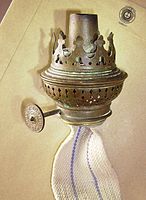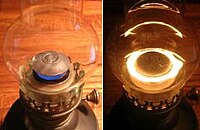Kerosene lamp
A kerosene lamp , also known as kerosene lamp , is a lamp that generates its light by burning kerosene gases.
history
It is not possible to name one (and only one) particular inventor of the kerosene lamp, nor is a year of its invention known. Oil ( English petroleum ) was already known for hundreds of years, but was rarely used for lighting because of the low light effect and the strong odor and soot. Some publications date the invention to the beginning of the 19th century, but the principle is likely to have been derived from that of oil lamps much earlier . Significant steps towards a functional kerosene lamp as we know it today were the invention of the lamp cylinder (Rhineland around 1810) and the round wick in 1854 by the Polish chemist Ignacy Łukasiewicz (1822–1882) in Lemberg , who was also one of the pioneers of petroleum distillation applies.
In addition, there were a number of necessary preliminary inventions, such as the well-functioning burners for argand lights , and the possibility of cleaning the crude oil by treating it with acids and alkalis and separating it into its components by fractional distillation in order to obtain fuels with significantly better properties than the crude oil. Last but not least, constant and extensive production of crude oil was required so that the new product could establish itself in terms of price. When the technical prerequisites were in place, the already existing oil lamps ( Carcell lamp and clockwork lamp , argand burner, moderator lamp ) had to be redesigned for the new fuel.
After adjustments to the fuel, the burner, the wick and the draft glass (lamp glass, lamp cylinder) to avoid the strong soot and the associated massive odor nuisance, petroleum lamps replaced the previously used oil lamps within a short time. A big advantage of petroleum as a fuel was its low viscosity : it rose much higher in a wick (over 10 cm) than any other oil previously used. It was also relatively cheap to get. To this day, kerosene lamps are made. There are also still glass cylinders, wicks, tanks and various burners on the market. In this way, old lamps can be repaired and continued to operate.
technology
Petroleum lamps usually consist of a tank, wick , burner and glass cylinder. The fuel rises through capillary action in the wick. The height of the wick can often be adjusted by means of a gear drive in the burner in order to replace burn-off. At the free end of the wick in the burner, the kerosene gasifies and can be lit.
The burner holds the wick and only supplies enough air for the flame to burn white and bright. Too little air lets the flame soot, too much air leads to a blue flame, which is unsuitable as a light source (see: Bunsen burner ).
Compared to candles, kerosene lamps have the advantage of greater brightness and much cheaper and longer operation. Candles have long been something special and expensive. Usually, kerosene lamps light up for 20 hours on a full tank. The brightness was previously given in Hefner candles (HK), which roughly corresponded to the brightness of a household candle . Depending on the burner design, wick width and burner size, the lamps had brightnesses of around 5 to 30 HK.
Lamp types
Wick lamps / draft lamps
- Types of lamp designs
Flat burner of a Lucas bicycle lamp
Burners are available in different designs, the best known are flat burners, cosmos burners and flame disc burners.
The cosmos burner, patented in 1865, goes back to a development by Wild and Wessel from Berlin. A flat, wide wick is guided in it in such a way that it converges in a circle at the top and the combustion air is supplied from outside and inside. The light output of this hollow wick or round burner is therefore much higher than that of the flat burner. The combustion is also cleaner; such a burner does not soot and hardly smells. The cosmos burner is one of the most popular burners, it was economical to operate and could be screwed onto almost any simple tank. The Deutsche Reichsbahn used cosmos burners in various car and signal lamps. This use was continued on the German railways into the 1980s. Some kerosene round burners use a round woven hollow wick, but must therefore draw the combustion air for internal ventilation of the flame through a central air pipe through the tank (so-called central draft lamp ). In these lamps, the tank is therefore more complicated.
The glass cylinder on the burner is important because its chimney effect ensures the correct draft of the combustion air. It also protects the flame from the wind. Different burner types require glass cylinders that are precisely matched to the respective design. So are z. B. the "Vienna cylinder" for flat burners, "Kosmos cylinder" for Kosmos burner or "Matador cylinder" for flame disc burners available.
The unit of measurement for the wick width and thus also the size of a kerosene burner is the line ( Paris line ). An 8-line (abbreviation 8 '' ') cosmos burner has a wick width of 42 mm and a screw thread diameter of 28 mm.
One way to increase the brightness was to use a flame disc. This flame (also incendiary) disc was placed a few millimeters above the end of the wick. The flame “hits” on the way up against this pane and becomes “wider” and therefore also a little brighter. Flame disc burners require a special glass cylinder with a spherical bulge in order to leave enough space for the flame. The brightness of these lamps is amazing, but so is the warmth they give off. Likewise, these burners are overly "thirsty". The consumption increases disproportionately. Lamps with such burners were almost exclusively found in "rich" households. Well-known models of this type are the Ideal and Matador burners.
Up until the end of the 1970s, construction site lanterns were still being used for traffic safety in many places , mostly from the make " Feuerhand 276" from Nier; in West Berlin even a few years longer. In eastern Germany, kerosene lamps made by BAT or Frowo were in use until the 1980s . They are hurricane lanterns with flat wick burners, which, due to the construction of the housing, can hardly be blown out even by strong winds. These lanterns have a fairly large tank that allowed them to burn for up to 70 hours.
Some of these construction site lanterns generated a flashing brightness curve, which attracts attention. For lighting purposes one tries to avoid flickering and soot by means of suitable construction and wick settings.
Kerosene incandescent lamps
Petroleum incandescent lamps are a combination of wick and high-intensity lamps. These lamps suck the fuel with the help of the wick from the tank below, burn it with a blue flame in order to supply a mantle with heat and gas. The brightnesses achieved are far greater than those of ordinary wick lamps. The Aladdin No. 23 a brightness that corresponds to a 50 watt incandescent lamp. Incandescent lamps were also available as petrol and spirit incandescent light.
High-intensity lamps
Petrol and kerosene lamps, known under the trade names Aida, AMG, BAT, Coleman, Continental , Ditmar, Geniol, Hasag , Mewa, Optimus, Petromax , Radius, SMP, Tilley, Vapalux, have a completely different function . Here light is generated similar to a gas lamp by means of an Auer incandescent body . These high-intensity lamps evaporate petrol or kerosene in a special carburetor, depending on the design. The fuel is pressurized in a tank using a built-in or external air pump. From there it gets into the carburetor and is heated so much that it evaporates. The gaseous fuel is mixed with air in a mixing tube, causing the incandescent body, also known as the mantle , to glow. This type of construction enables a significantly higher light output than conventional wick lamps. However, the operation and maintenance of such a high-intensity lamp are more complicated and time-consuming than that of a wick lamp, so high-intensity lamps with a carburettor generally have to be preheated. Denatured alcohol is usually used for this purpose. In the case of a few lanterns, the preheating device is designed for petroleum, e.g. B. Petromax 824N. The Rapidstarter is an alternative design: fuel is pressed out of the tank through a nozzle using compressed air and atomized. This fuel-air mixture is ignitable and can be used to heat the carburetor.
See also
Web links
- Lamps on scherning.de
- Lumière de l'œil, Paris
- Petromax page T.Baumgärtner
- Collectors website
- Petrol lamp collection
- Continental strong light lamps
- Information collection Jürgen Breidenstein
literature
- Wilhelm Gentsch : The petroleum lamp and its components , Berlin 1896; napoleum.de , (PDF; 115 MB)
Individual evidence
- ↑ Werner Touché: Shining Past . See the experiment by W. Touché, Borken District Museum , 1999, ISBN 3-927851-50-7 , p. 47
- ↑ rheinische-industriekultur.de
- ↑ Werner Touché: Shining Past . Experiment by W. Touché. Borken District Museum , 1999, ISBN 3-927851-50-7 , p. 41
- ↑ Dr. D. Bunk: Nier-Feuerhand storm lanterns: 100 years of industrial history . bunk-online.de from July 28, 2008
- ↑ Flashing kerosene lamps






